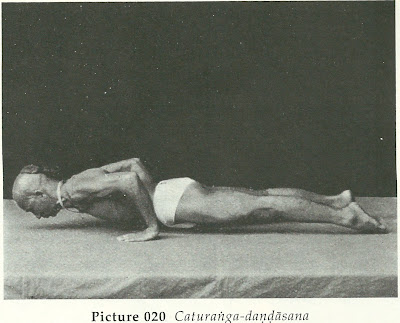See the ongoing Yogasangalu translation project for the translation so far.
Translation by Satya Murthy.
Translation by Satya Murthy.
Pages 30-31 regarding "special benefits" is done. Next section is Mudras which he skips by referring to yogamakaranda" and then kriyas.
Summary: In the practitioner who performs the above described bandha according to the instructions of his guru, brain essence can not be destroyed by the jataragni. In addition, relief from gas related abdominal bloating is also achieved.
In Pranayama, all three bandhas must be practiced. After rechaka, one must do jalandharabandha, moolabandha and uddiyanabandha while after puraka, moolabandha and jalandarabandha must be followed without fail during pranayama.
In yogashastra, one must do 320 pranayamas everyday. This means that it was classfied as 80 in the morning, 80 in the afternoon, 80 in the evening and 80 in mid-night. Since this is impossible, one can do 80 pranayama in one sitting. The reason is that now a days, you need to spend more time working to support your life. Benefits are delayed too.
Rechaka, puraka and kumbhaka when practiced with equal time and equal numbers are called “Samavrutti pranayama.”
When practiced with variations (increase and/or decrease) in time and numbers it is called “Vishamavrutti pranayama”.
Those who learn it from a Guru will learn to practice properly.
Those who are not proficient in yogasana will not be able to get expertise in pranayama.
Women who are not pregnant have equal rights as men. Even in pregnancy they have the right to practice samasankya samavrutti pranayama. However, after the 6-month of pregnancy, they can not practice that (samavrutti pranayama) also. Yoganga applies equally to both men and women except during pregnancy - please remember this.
Some are saying that Nauli, Neti, Vasti, Vajroli, Dhauti, Khechari etc., kriyas are also part of yoganga and propagating such information through various texts is very unfortunate.
Any text that shows a list of yogangas does not say so. “Hatayogapradipika” lists them under a separate heading “Shatkriyas” and in the same text clearly states that everyone should not practice it.
मेदःश्लेश्माधिकः पूर्वं षटकर्माणि समाचरेत्।
अन्यस्तु नाचरेत्तानि दोषाणां समभावतः॥
Medha shleshmadhikah poorvam shatkarmani samacharet|
Anystu nacharettani doshanam samabhavatah||
Therefore, we should pay attention to this rule and use it only as treatment for certain diseases such as those caused by excess fat.
In Pranayama, all three bandhas must be practiced. After rechaka, one must do jalandharabandha, moolabandha and uddiyanabandha while after puraka, moolabandha and jalandarabandha must be followed without fail during pranayama.
In yogashastra, one must do 320 pranayamas everyday. This means that it was classfied as 80 in the morning, 80 in the afternoon, 80 in the evening and 80 in mid-night. Since this is impossible, one can do 80 pranayama in one sitting. The reason is that now a days, you need to spend more time working to support your life. Benefits are delayed too.
Rechaka, puraka and kumbhaka when practiced with equal time and equal numbers are called “Samavrutti pranayama.”
When practiced with variations (increase and/or decrease) in time and numbers it is called “Vishamavrutti pranayama”.
Those who learn it from a Guru will learn to practice properly.
Those who are not proficient in yogasana will not be able to get expertise in pranayama.
Women who are not pregnant have equal rights as men. Even in pregnancy they have the right to practice samasankya samavrutti pranayama. However, after the 6-month of pregnancy, they can not practice that (samavrutti pranayama) also. Yoganga applies equally to both men and women except during pregnancy - please remember this.
Some are saying that Nauli, Neti, Vasti, Vajroli, Dhauti, Khechari etc., kriyas are also part of yoganga and propagating such information through various texts is very unfortunate.
Any text that shows a list of yogangas does not say so. “Hatayogapradipika” lists them under a separate heading “Shatkriyas” and in the same text clearly states that everyone should not practice it.
मेदःश्लेश्माधिकः पूर्वं षटकर्माणि समाचरेत्।
अन्यस्तु नाचरेत्तानि दोषाणां समभावतः॥
Medha shleshmadhikah poorvam shatkarmani samacharet|
Anystu nacharettani doshanam samabhavatah||
Therefore, we should pay attention to this rule and use it only as treatment for certain diseases such as those caused by excess fat.













